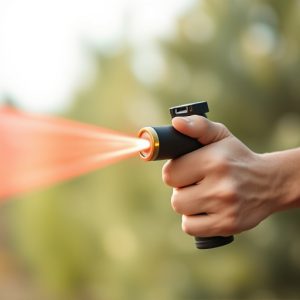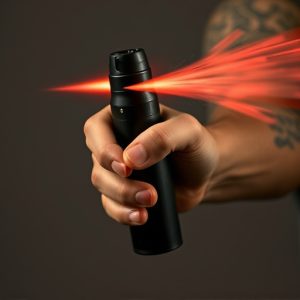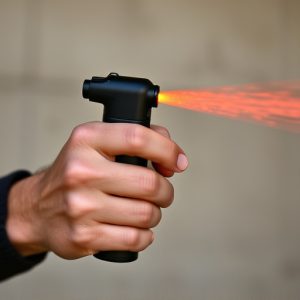Mastering Pepper Spray Defense Against Dog Attacks: Complete Guide
Pepper spray, a non-lethal self-defense tool against dogs, disrupts their sense of smell and sight w…….
Pepper spray, a non-lethal self-defense tool against dogs, disrupts their sense of smell and sight with capsaicin, temporarily disorienting them. For effective defense, choose animal-specific pepper spray with higher capsaicin concentrations, suitable spray pattern, and range. Target the dog's eyes and nose from 3-5 feet with short bursts of 2-3 seconds. Always understand local laws, practice safe handling, and wear protective clothing during encounters.
“Maximize your safety with a strategic approach to pepper spray defense against dog attacks. This comprehensive guide explores the power of this non-lethal tool, offering insights into its role in deterring and managing aggressive canine encounters. From understanding the spray’s mechanism to choosing the right formulation and mastering application techniques, we equip you with vital knowledge. Learn about legal considerations and safe handling practices, ensuring you’re prepared for any situation. Discover how the correct pepper spray defense can be a game-changer in potentially dangerous dog interactions.”
- Understanding Pepper Spray: A Non-Lethal Self-Defense Tool
- The Role of Pepper Spray in Dog Attacks: What to Expect
- Choosing the Right Pepper Spray for Maximum Protection
- Effective Application Techniques for Optimal Effectiveness
- Legal Considerations and Safe Handling Practices
Understanding Pepper Spray: A Non-Lethal Self-Defense Tool
Pepper spray, also known as oleoresin capsicum (OC) spray, is a non-lethal self-defense tool designed to incapacitate an attacker temporarily. It works by causing intense irritation and pain in the eyes, nose, and respiratory system, leading to temporary blindness, coughing, and difficulty breathing. When used against dogs, pepper spray can be an effective defense mechanism, as it disrupts their sense of smell and sight, giving you precious time to escape or summon help.
Understanding how pepper spray works is crucial for its effective use. Unlike some self-defense tools that rely on physical force, pepper spray takes advantage of a natural chemical compound found in chili peppers. When sprayed, the OC particles bond with the mucous membranes, triggering a severe inflammatory response. This reaction neutralizes an attacker’s ability to function normally, allowing you to defend yourself and create a safe escape route.
The Role of Pepper Spray in Dog Attacks: What to Expect
In the face of a dog attack, understanding the effectiveness of pepper spray as a defense mechanism is paramount. Pepper spray, when deployed correctly, can serve as a powerful deterrent against aggressive dogs. Its primary active ingredient, capsaicin, irritates the eyes and respiratory system of the canine assailant, temporarily disorienting it and providing the victim with an opportunity to escape or seek help. This temporary incapacitation can be crucial in diffusing potentially dangerous situations.
When facing a dog attack, individuals should aim for the animal’s face, specifically its eyes and nose, as these areas are most sensitive to pepper spray. A direct and accurate application can significantly reduce the dog’s aggression. However, it is important to note that pepper spray is not a guaranteed solution. Its effectiveness varies based on factors such as the dog’s breed, size, training, and the severity of its attack. Therefore, individuals should always prioritize preventive measures like maintaining a safe distance from unfamiliar dogs and being prepared with appropriate self-defense tools alongside proper knowledge and awareness of local laws regarding pepper spray usage.
Choosing the Right Pepper Spray for Maximum Protection
When considering a pepper spray defense against dogs, it’s crucial to understand that not all sprays are created equal. The key to maximum protection lies in selecting a product designed specifically for animal encounters, as these formulations tend to be more potent and consistent. Look for sprays with higher capsaicin concentrations, the active ingredient responsible for the burning sensation, typically measured in milli-units (mg/g).
Additionally, consider factors like spray pattern and range. A wide spray pattern ensures coverage against a dog’s face and eyes, while a longer range allows you to maintain distance during an attack. Always check reviews and, if possible, test different brands to find the one that offers the best combination of power, reach, and ease of use—essential elements for an effective pepper spray defense against dogs.
Effective Application Techniques for Optimal Effectiveness
When deploying pepper spray as a defense against dogs, understanding effective application techniques is key to optimal effectiveness. Aim for the eyes and nose—these sensitive areas can quickly disable an aggressive dog. Hold the canister at close range (around 3-5 feet) and spray in short bursts of 2-3 seconds. This method delivers a concentrated dose directly into the animal’s face, causing temporary blindness and irritation that should give you time to retreat or defuse the situation.
Remember, consistency is crucial. If the dog shows no signs of retreating after the initial burst, don’t hesitate to refill and apply again. Always ensure you’re using pepper spray specifically designed for animal encounters—these formulations are typically stronger and formulated to break down more quickly on animal fur and in eyes, minimizing harm to non-target species or environments.
Legal Considerations and Safe Handling Practices
When employing a pepper spray defense against dogs, it’s crucial to understand the legal considerations in your region. While pepper spray is an effective deterrent for dog attacks, its use is regulated by laws designed to protect both citizens and animals. Always check local regulations regarding the possession, carrying, and use of pepper spray to ensure compliance. Some areas may restrict its use solely to law enforcement or have specific requirements for permit-carrying individuals.
Safe handling practices are paramount when dealing with pepper spray. Store it securely in a designated area, away from children and unauthorized individuals. Familiarize yourself with the spray’s operating mechanism and range to ensure effective deployment during an encounter. Regularly maintain and inspect the spray device, replacing it as needed. Additionally, be mindful of wind direction and nearby water sources, as these can affect the spray’s effectiveness and spread. Wear protective clothing when possible to minimize exposure to the spray.
Pepper spray can be a powerful tool for defending against dog attacks, offering a safe and effective solution for individuals seeking protection. By understanding its mechanisms, learning proper application techniques, and adhering to legal guidelines, you can maximize the effectiveness of pepper spray as a self-defense measure. Armed with knowledge and the right product, you’ll be better equipped to handle potential encounters and ensure your safety when facing aggressive dogs.


